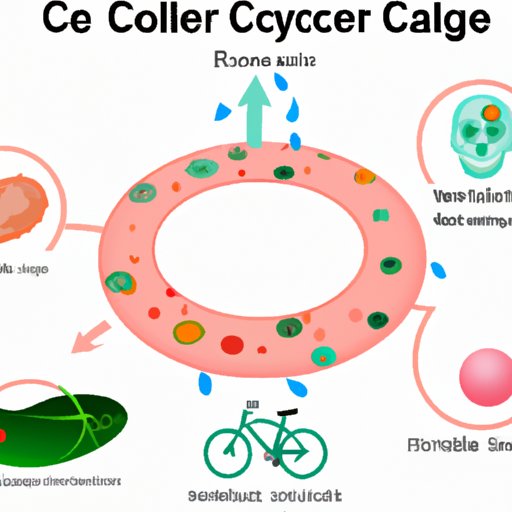Can Disrupting the Cell Cycle Help Fight Cancer?
The cell cycle is a fundamental process in the growth and division of healthy cells. It is a complex, tightly regulated, and carefully orchestrated series of events that involve the duplication of DNA, followed by chromosomal segregation and cytokinesis. The proper regulation of this process is essential for maintaining healthy cell growth and ensuring that cells do not divide uncontrollably, which can lead to diseases such as cancer.
In this article, we will explore different factors that can disrupt the cell cycle and their potential for fighting cancer. We will dive into radiation and chemotherapy drugs, environmental factors, nutritional deficiencies, genetic mutations, viruses, and natural compounds. We will weigh the potential risks and benefits of disrupting the cell cycle with various treatments and discuss the importance of further research in this area.
Overview of Common Factors That Disrupt the Cell Cycle
Radiation therapy and its effects on cell division
Radiation therapy is a common treatment for cancer that uses ionizing radiation to destroy cancer cells. The radiation can damage cancer cells’ DNA, causing them to stop dividing and die. However, radiation therapy can also damage healthy cells and cause them to stop dividing temporarily or permanently, leading to side effects such as fatigue, skin irritation, and hair loss.
Chemotherapy drugs and their impact on rapidly dividing cells
Chemotherapy drugs are another type of treatment for cancer that target rapidly dividing cells. They work by disrupting the cell cycle and preventing cancer cells from dividing and spreading. However, chemotherapy drugs can also damage healthy cells, including those that are rapidly dividing in the bone marrow, hair follicles, and digestive tract. This can lead to side effects such as anemia, hair loss, and nausea.
Environmental factors such as pollution or toxins
Exposure to environmental toxins and pollutants can also disrupt the cell cycle and lead to the development of cancer. Carcinogens, such as tobacco smoke, asbestos, and ultraviolet radiation, can damage DNA and cause mutations that lead to cancer. Other environmental factors, such as a high-fat diet, can also affect cell growth and division.
Nutritional deficiencies and their effect on cellular growth
Nutritional deficiencies, such as a lack of vitamins or minerals, can also disrupt the cell cycle and lead to abnormal cell growth. For example, a deficiency in folate, a B-complex vitamin, can cause DNA damage and affect the normal replication and division of cells.
How Viruses Can Disrupt the Cell Cycle and Lead to Cancer
Viruses can also disrupt the cell cycle by hijacking the normal processes of cells and causing them to divide uncontrollably. For example, human papillomavirus (HPV) can enter cells and interfere with their normal regulation of the cell cycle, leading to the development of cervical cancer.
Other viruses, such as hepatitis B and C, can cause liver cancer by damaging liver cells and triggering an abnormal growth response. Epstein-Barr virus is associated with several types of cancer, including Hodgkin’s lymphoma and stomach cancer.
Researchers are exploring how to use this knowledge of viruses’ effects on the cell cycle to develop cancer treatments that target specific viruses. There are already several vaccines available that can prevent HPV infections and reduce the risk of cancer.
Genetic Mutations and Their Impact on the Cell Cycle
Genetic mutations can also disrupt the cell cycle and lead to the development of cancer. Some mutations can activate growth-promoting genes, while others can deactivate tumor-suppressing genes. Mutations in genes that regulate the cell cycle can cause cells to divide uncontrollably, leading to the development of cancer.
Some mutations are inherited, while others are acquired. Inherited mutations are passed down from parents to their children and can increase the risk of developing certain types of cancer. Acquired mutations are caused by environmental factors, such as exposure to carcinogens or aging.
Natural Compounds and Their Potential to Disrupt the Cell Cycle in Cancer Cells
Natural compounds, such as flavonoids, polyphenols, and alkaloids, have been shown to have potential in disrupting the cell cycle and stopping cancer growth. For example, curcumin, a compound found in turmeric, has been found to induce cell death in cancer cells by disrupting the cell cycle’s normal progression.
However, the use of natural compounds in cancer treatment is still in its early stages, and more research is needed to understand their full potential. Researchers are also exploring the possibility of combining natural compounds with traditional cancer treatments, such as chemotherapy and radiation, to enhance their effectiveness and reduce side effects.
Examination of the Potential Risks and Benefits of Disrupting the Cell Cycle with Various Treatments
Disrupting the cell cycle with various treatments can have both potential risks and benefits. Traditional treatments, such as radiation and chemotherapy, can be effective in targeting rapidly dividing cancer cells. However, they can also damage healthy cells and cause side effects such as fatigue, nausea, and hair loss.
Targeted therapies, such as monoclonal antibodies and kinase inhibitors, are designed to disrupt specific proteins that play a role in cancer growth. These therapies can be more effective and cause fewer side effects than traditional treatments. Personalized medicine, which uses genetic information to tailor cancer treatments to individual patients, is another promising area of research.
Conclusion
Disrupting the cell cycle is a promising approach to fighting cancer, and researchers are exploring different methods to achieve this, from radiation and chemotherapy to natural compounds and targeted therapies. While the field is still in its early stages, it holds promise for the development of more effective cancer treatments that can improve outcomes for patients.
Continued research and investment in this area are essential to unlocking the full potential of disrupting the cell cycle for better cancer treatment outcomes.
